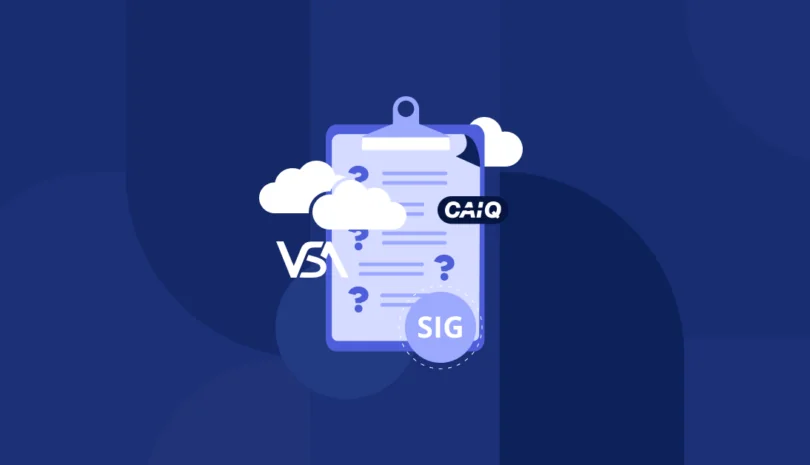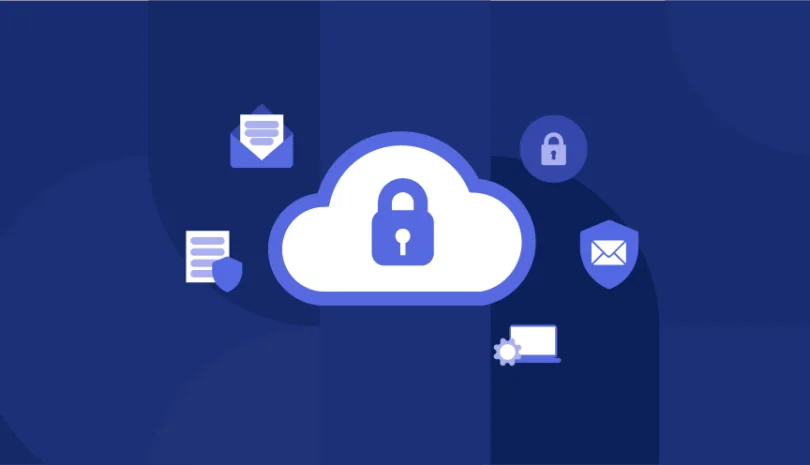Cybersecurity and information security may sound like two different terms for the same idea, but while they’re related, they’re actually different concepts. What is cybersecurity? What is information security? And what’s the actual difference between them?
Cybersecurity vs Information Security
While cybersecurity focuses on defending an organization’s systems and network against an attack, information security focuses on guarding against unauthorized access to sensitive data. In addition, information security focuses on all types of data, not only digital data but paper documents and intellectual data (e.g. patents, copyrights, and trade secrets). As a result, cybersecurity is considered a field within information security.
Cybersecurity Definition
Let’s start with a definition of cybersecurity. You’ll get a different definition for this depending on which organization you’re consulting. For example, according to ISO, cybersecurity is the “preservation of confidentiality, integrity, and availability of information in cyberspace.” And according to CISA, “Cybersecurity is the art of protecting networks, devices, and data from unauthorized access or criminal use and the practice of ensuring confidentiality, integrity, and availability of information.”
But the simple version is this: cybersecurity is about protecting an organization from hacking, attacks, breaches, and other forms of unauthorized access from the outside world. With the right framework, an organization can proactively detect these threats, prevent them from happening, and respond to them if they’re already in progress. This includes threats from third, fourth, and even fifth parties that can directly impact your organization.
Cybersecurity is also concerned with data that natively has a digital form. For example, digital files and data stored on your computer are natively digital. Any discussion of cybersecurity is, by definition, discussing digital information, systems, networks, and processes. Protecting your data has become increasingly complex when organizations outsource their IT infrastructure to third parties, who may then outsource parts of that same service to a fourth or fifth party. For example, a financial service provider may share its customer data with a third-party payment provider, who then stores the financial service provider’s customer data on fourth-party cloud infrastructure (e.g., AWS or Google).
Information Security Definition
So what is information security?
According to NIST, information security (or InfoSec) is “The protection of information and information systems from unauthorized access, use, disclosure, disruption, modification or destruction in order to provide confidentiality, integrity, and availability.” In other words, information security is all about protecting the integrity, accessibility, and confidentiality of data no matter what form it takes. Instead of designing security processes around your digital PDFs, you’ll also need to think about the filing cabinets full of files in your office.
Ultimately, information security aims to protect your information and information systems by preserving it in three ways:
- Integrity. First, your information needs to be protected in terms of its integrity. In other words, it needs to be prevented from being modified or destroyed. The authentic information must be preserved in its original form at all costs.
- Availability and accessibility. Information also needs to remain available and accessible to the people who need it. Leaders and team members within your organization should be able to access information whenever they need it.
- Confidentiality and privacy. Finally, information needs to remain confidential. In other words, it shouldn’t be accessible by unauthorized parties. It also needs to remain compliant with privacy policies and should keep proprietary information protected.
Cybersecurity and Information Security: What Are the Differences?
Are you still confused? It’s understandable, considering the significant overlap between these two concepts. But cybersecurity and information security are differentiated in a few important ways:
- Type of information. Cybersecurity is focused on protecting your organization’s information when it’s in a digital format. However, information security is concerned with all types of information, including physical, and tangible information. It’s all more specifically focused on protecting the confidentiality, integrity, and availability of sensitive data. However, there’s still some significant overlap here, considering information security also needs to consider digital information.
- Mode of protection. The type of protection offered by cybersecurity and information security also differ. Information security is all about protecting your information in terms of its confidentiality, integrity, and availability. By contrast, your cybersecurity strategy will be more focused on guarding against specific threats of unauthorized access, including hacks and data breaches.
- Threat analysis. In the cybersecurity world, you have to think like a hacker. You need to understand how malware works, familiarize yourself with common types of cyberattacks, and guard against them. But in the information security world, you need to be prepared for all types of threats, including natural disasters as well as human-originated potential issues.
How Cybersecurity and Information Security are Similar
The cause for confusion is that most cybersecurity attacks involve gaining authorized access to, modifying, deleting or exfiltrating sensitive data. This is where the two fields overlap, and share certain goals.
For example, each involve:
- An aim to protect information. Both cybersecurity and information security have the same goal: to protect information within an organization. Though they may target slightly different types of information and protect it in slightly different ways, your organization’s information remains the top priority for both these systems. However, both the cybersecurity and information security strategies of your third, fourth and fifth parties can directly impact your own security posture and the security of your data.
- Proactive and reactive measures. In both cybersecurity and information security, you’ll need to establish proactive and reactive measures for your security strategy, respectively. As a first line of defense, you must establish protective measures that prevent attacks, breaches, and other threats from occurring. You can proactively monitor your systems to observe potential threats and work actively to ward them off. But you’ll also need response plans in place regarding what your organization will do in the event of a live attack, or a data breach in your supply chain that directly impacts your operations or security. How are you going to respond if your first line of defense fails?
- Demand for risk assessment and hierarchies. In cybersecurity and information security, you’ll need to spend time evaluating risk and establishing hierarchies within your organization. For example, which types of data are most important to protect? Which ones are indispensable for your organization, and which ones are expendable? What legal compliance must your organization adhere to? What are the biggest risks and threats you face as an organization? What are the biggest potential risks from your third parties, and how can you prioritize them according to the?
- Need for security processes and documentation. Neither cybersecurity nor information security can be improvised or written off as unimportant. To be successful in either area, you’ll need to spend time coming up with a specific process for protection and document it. It is important to also verify that your third parties have similar processes and documentation in place as it is critical for meeting compliance and regulations, regular audits, and so that you are prepared in the event of a third-party data breach or supply chain attack.
Why Cybersecurity and Information Security are Critical for Third-Party Security
Having a cybersecurity strategy isn’t enough to protect your organization; it will leave your non-digital information vulnerable to attack. Similarly, an information security plan alone won’t suffice to protect your organization from hackers and other external, digital threats.
If you want your organization to remain secure, protected, and compliant, you need both cybersecurity and information security strategies. These complementary forces must work together for the hygiene and safety of your organization.
Unfortunately, just because you take cybersecurity and information security seriously, doesn’t mean your third parties do. Since your vendors have access to your assets, it behooves you to properly vet new third-party vendors as well as continuously monitor them. Doing this will help ensure the security hygiene of your vendors is up to snuff. This can be accomplished by combining security questionnaires with external attack surface assessments and business context.
How Panorays Can Help
You can’t afford to ignore either third-party cybersecurity or information security. As the only contextualized risk platform on the market, Panorays helps you strengthen your third-party security by pinpoints early threat indications within the unique context of every relationship, allowing companies to adapt their defenses and proactively prevent the next breach from affecting their business.
Its modules include:
- Supply Chain Discovery. Automatically discover unknown third, fourth, and n-th parties in your supply chain and define the relationship between your organization and each third party so that you have a better understanding of how data is shared between the different parties.
- Risk DNA Assessments. Conduct both internal and external assessments of your third parties and determine each supplier’s risk appetite. Risk DNA also takes into account all third-party breach history and generates AI-driven predictions for future data breaches. All of these elements work together to deliver the most accurate cyber risk rating of your third parties on the market today.
- Continuous Threat Detection. Leverage third-party threat intelligence and a contextualized view of your supply chain to get alerts of any relevant data breaches or supply chain attacks from third parties.
- Remediation and Collaboration. Close supplier gaps immediately with an aggregated remediation plan for each vendor. Each plan takes into consideration your risk appetite, critical findings, and potential business impact of each risk.
Want to learn more about how Panorays can help you manage third-party risk? Get a demo today!
Cyber Security vs Information Security FAQs
-
Cybersecurity focuses on defending an organization’s systems and network against an attack, while information security focuses on guarding against unauthorized access to sensitive data. Information security focuses also on all types of data, not only the digital data which is the focus of cybersecurity.
-
Information security is guarding against unauthorized access to sensitive data. This includes all types of data, not only digital data but also paper documents and intellectual data (e.g. patents, copyrights, and trade secrets).
-
Cybersecurity is the combination of people, technology, and processes a company has in place to defend against digital attacks. These attacks aim to steal, gain authorized access to, and modify sensitive data within a company. They also may interrupt operations or extort money from organizations.



